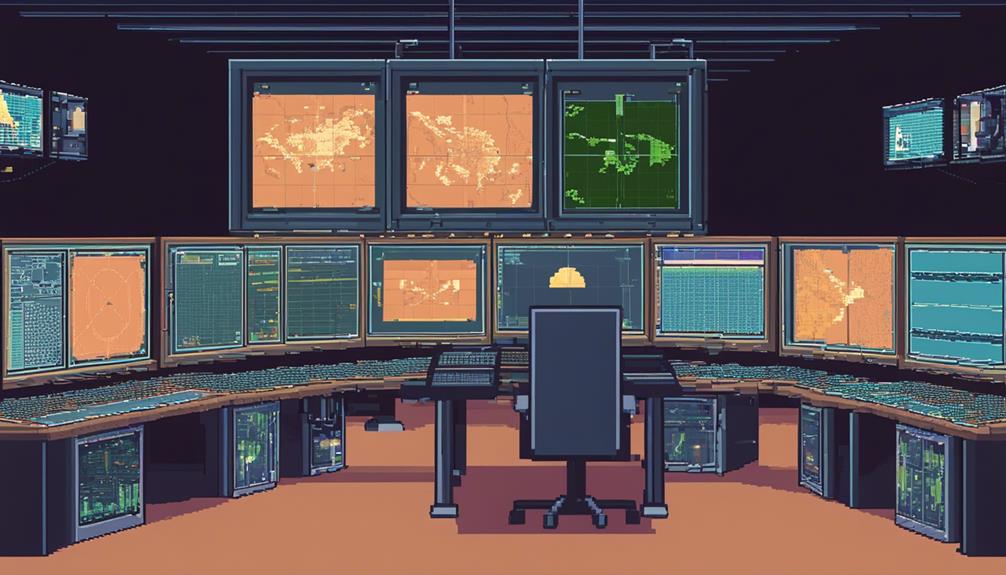In the intricate realm of ground stations, the role of software cannot be overstated. From managing satellite telemetry to executing complex command sequences, the software utilized in ground stations is the linchpin of efficient satellite communication systems. These sophisticated tools not only enable real-time monitoring and control but also play a pivotal role in data processing and signal analysis. The precision and reliability demanded in this domain necessitate a deep dive into the intricacies of the software landscape, where innovation and optimization are paramount for seamless operations and enhanced performance.
Key Takeaways
- Tracking software enables automated satellite communication and continuous link maintenance.
- Antenna control systems ensure precise tracking and optimize signal strength for reliable communication.
- Satellite telemetry monitoring software tracks satellite health in real-time for smooth operations.
- Signal processing applications enhance communication efficiency and data transfer rates for ground stations.
Tracking Software for Satellite Communication
Tracking software for satellite communication is a critical component of ground station operations, enabling automated satellite tracking and continuous link maintenance. Satellite ground stations rely on this software to automatically follow and communicate with satellites once they are acquired. The software's primary function is to ensure a seamless connection between the ground station and the satellite, facilitating efficient data transfer and communication.
One of the key features of tracking software for satellite communication is antenna tracking. This aspect is crucial for maintaining a stable and continuous link between the ground station's antennas and the orbiting satellites. The software enables precise tracking of satellites across different orbits and frequencies, ensuring that the antennas are always pointed in the right direction for optimal communication.
Moreover, the automatic tracking capabilities embedded within the software play a vital role in optimizing communication efficiency and data reception. By automatically adjusting the antennas to track the satellites, the software minimizes signal disruptions and maximizes the quality of data transmission between the ground station and the satellite. This automation not only enhances operational efficiency but also reduces the risk of data loss during communication sessions. In essence, tracking software is a fundamental tool for satellite ground stations to maintain reliable and uninterrupted communication with satellites in orbit.
Data Processing Tools for Ground Stations
Ground stations rely on sophisticated data processing tools to analyze and interpret the vast amounts of satellite data received, enabling the extraction of valuable insights crucial for maximizing the effectiveness of satellite missions. These data processing tools are an integral part of ground systems, playing a vital role in handling telemetry, images, and various other forms of data transmitted by satellites.
The software used in ground stations processes raw satellite data to generate reports, visualizations, and actionable insights. By leveraging these tools, ground station operators can efficiently extract valuable information from the data received, aiding in decision-making and mission planning. The ability to quickly and accurately process satellite data is essential for ensuring the success of satellite missions.
Effective data processing tools streamline the analysis of satellite data, allowing for the identification of patterns, anomalies, and trends that might otherwise go unnoticed. By harnessing the power of these tools, ground stations can enhance their operational efficiency and derive maximum value from the data collected during satellite missions. In conclusion, data processing tools are indispensable components of ground stations, facilitating the transformation of raw satellite data into valuable insights that drive the success of satellite missions.
Antenna Control Systems in Ground Stations

Antenna control systems are integral components of ground stations, facilitating the precise tracking and communication with satellites in orbit. These systems employ advanced algorithms and feedback mechanisms to ensure accurate antenna positioning in real-time, optimizing signal strength and quality during satellite communication. Ground station automation is achieved through the seamless integration of antenna tracking technology, enabling remote station communication and efficient satellite signal reception.
Antenna Tracking Technology
Utilizing sophisticated control systems, ground stations employ advanced technology to automatically adjust the position of antennas for continuous and precise satellite communication. Antenna tracking technology in ground stations enables automatic tracking of satellites once acquired, ensuring uninterrupted communication. These systems utilize precision algorithms to adjust antenna positions, maintaining a strong signal lock on the satellite. The technology optimizes data transfer efficiency and ensures a reliable link with satellites orbiting Earth. Real-time monitoring and adjustments compensate for satellite movements and signal variations, guaranteeing seamless communication. Below is a table highlighting the key aspects of antenna tracking technology in ground stations:
| Aspect | Description | Importance |
|---|---|---|
| Automation | Automatically adjusts antenna positions for continuous satellite tracking | Ensures connectivity |
| Precision Algorithms | Utilizes advanced algorithms for accurate antenna positioning | Maintains signal lock |
| Real-time Monitoring | Allows for immediate adjustments to compensate for satellite movements | Ensures reliability |
Remote Station Communication
Sophisticated remote station communication systems in ground stations facilitate precise tracking and communication with satellites. These systems are crucial for maintaining a stable link with satellites during their orbit. Key aspects of remote station communication include:
- Motorized Adjustment: Antenna Control Systems utilize motors and controllers to adjust the position of antennas, ensuring optimal signal reception from satellites.
- Continuous Tracking: Antenna Control Systems track satellites across the sky, enabling uninterrupted communication by maintaining alignment with the moving satellites.
- Software Interfaces: Ground stations utilize software interfaces to control the movement and alignment of antennas, allowing operators to interact with and manage the communication process effectively.
Antenna Control Systems play a vital role in establishing and maintaining communication links with satellites.
Ground Station Automation
Ground station automation, powered by Antenna Control Systems (ACS), revolutionizes satellite tracking and communication processes with its automated precision and efficiency. ACS enables automatic tracking and pointing of antennas towards satellites orbiting the Earth, reducing the need for manual intervention in adjusting antenna positions. By utilizing ACS, ground stations maintain a stable link with satellites, optimizing data transmission and reception processes. This automation significantly enhances the efficiency of satellite communication, ensuring that the antennas are always precisely aligned with the satellites in orbit. Ground station automation with ACS streamlines operations, improves accuracy, and ultimately boosts the overall performance of satellite tracking and communication systems.
Satellite Telemetry Monitoring Software

Satellite telemetry monitoring software is a critical tool that enables real-time tracking and monitoring of satellite health and performance. This software plays a pivotal role in ensuring the smooth operation of satellites by providing essential data on various parameters. Here are key aspects highlighting the significance of satellite telemetry monitoring software:
- Data Collection: Satellite telemetry software collects crucial information such as satellite position, attitude, power levels, and system status. This data is essential for understanding the overall health and operational status of the satellite.
- Issue Detection and Troubleshooting: Operators rely on telemetry software to detect anomalies and troubleshoot any issues that may arise during satellite operations. By monitoring the telemetry data, operators can promptly address problems and ensure the satellite functions optimally.
- Analysis and Decision-Making: Users can access telemetry data for in-depth analysis, trend monitoring, and informed decision-making. This data-driven approach allows operators to make strategic decisions to optimize satellite performance and mission success.
Signal Processing Applications for Ground Stations
Building upon the crucial role of software in satellite operations, signal processing applications in ground stations are fundamental for enhancing communication efficiency and data transfer rates. Signal processing involves various tasks such as filtering, amplifying, and modulating signals to ensure effective communication with satellites. These applications are essential for extracting crucial information from received signals, including telemetry data and commands for the satellite. Ground station software employs sophisticated signal processing algorithms to enhance signal quality and reliability, enabling seamless communication between the ground station and the satellites.
To provide a clearer overview, the table below outlines key aspects of signal processing applications in ground stations:
| Signal Processing Applications | Description |
|---|---|
| Filtering | Removes noise and interference from signals to improve clarity. |
| Amplifying | Boosts signal strength for better transmission over long distances. |
| Modulating | Converts data into suitable formats for transmission and reception. |
| Decoding/Encoding | Translates incoming and outgoing data signals for effective communication. |
Advanced signal processing techniques not only facilitate decoding and encoding of data but also significantly enhance communication efficiency and data transfer rates, making them indispensable components of ground station operations.
Remote Sensing Software for Satellite Tracking
Remote sensing software for satellite tracking plays a crucial role in monitoring and updating satellite orbits in real-time. These tools provide essential data visualization capabilities that aid in understanding and analyzing the satellite's movements. By offering accurate position updates, remote sensing software enhances the efficiency of satellite communication systems.
Tracking Satellite Orbits
Tracking satellite orbits is crucial in the realm of satellite operations and management, providing essential data for precise monitoring and control of satellite positions. Remote sensing software for satellite tracking plays a significant role in this process by offering real-time monitoring capabilities and detailed information on satellite positions, velocities, and trajectories. This software enhances mission planning and satellite communication management for space missions. Additionally, users can simultaneously track multiple satellites, enabling efficient coordination and monitoring of various spacecraft in orbit. The software also aids in predicting satellite passes over specific locations, allowing for better scheduling of communication windows and data collection activities.
Real-Time Position Updates
Ensuring the accuracy of satellite tracking operations necessitates the seamless integration of real-time position updates facilitated by advanced remote sensing software designed specifically for monitoring satellite movements. Remote sensing software continuously monitors satellite positions, utilizing GPS data and orbital parameters to calculate and update their locations dynamically. These updates are crucial for tracking satellites within various satellite constellations accurately during remote sensing activities. By providing up-to-date location information, the software enables efficient data collection and analysis. Satellite tracking software plays a fundamental role in ensuring precise tracking and data acquisition, enhancing the overall effectiveness of remote sensing operations. The integration of real-time updates is essential for maintaining the integrity and reliability of satellite tracking systems.
Data Visualization Tools
Data visualization tools within remote sensing software for satellite tracking play a critical role in transforming satellite data into actionable insights for monitoring and analysis.
Key Points:
- Network Analysis: These tools enable the visualization of satellite networks, showcasing connections between satellites and ground stations for efficient monitoring.
- Trajectory Mapping: Visualization software plots satellite movements and trajectories, aiding in predictive analysis of future positions accurately.
- Data Point Representation: By visually representing data points collected from satellites, users can interpret patterns, trends, and anomalies for informed decision-making.
These features empower users to optimize satellite operations, enhance mission effectiveness, and streamline monitoring processes within the satellite tracking network.
Command and Control Software in Ground Stations

Command and control software utilized in ground stations plays a critical role in overseeing the movement and monitoring of satellites during space operations. These software systems are essential for the efficient functioning of ground stations, enabling operators to facilitate satellite movements, monitor their functions, and ensure overall mission success.
One key function of command and control software is the real-time detection of anomalies. By continuously monitoring satellite operations, these systems can promptly identify any irregularities or malfunctions, allowing operators to take immediate corrective actions. Additionally, these software solutions play a crucial role in maintaining continuous communication links with the satellites, ensuring seamless data transmission and reception.
Moreover, command and control software provides deep access to setup parameters, allowing operators to configure various settings based on mission requirements. This level of control is essential for optimizing system performance and ensuring that the satellites operate at their full potential throughout the mission duration.
For first-time users of ground station software, Mission Planner is a recommended option due to its user-friendly interface and comprehensive features tailored for space operations. Similarly, QGroundControl is popular for its suitability for small format devices, making it a versatile choice for managing satellite operations efficiently.
Integration Platforms for Ground Station Operations
Integration platforms play a crucial role in facilitating coordinated and efficient ground station operations for satellite communications. These platforms serve as the backbone for managing various tasks and systems within a ground station environment, ensuring seamless communication and control over space missions. Here are some key aspects highlighting the significance of integration platforms:
- Centralized Data Management: Integration platforms enable the centralized management of data generated during space missions, including telemetry, command inputs, and mission-critical information. This centralized approach enhances data accessibility, security, and organization, facilitating streamlined operations for ground station personnel.
- Interoperability with Hardware and Software: Integration platforms are designed to integrate seamlessly with a wide range of hardware components and software applications used in ground stations. This interoperability ensures compatibility with diverse systems, enabling efficient communication and control across different equipment and tools deployed in the space environment.
- Automated Workflows: Integration platforms offer automation capabilities that help streamline workflows and routine processes within ground stations. By automating tasks such as data processing, system monitoring, and report generation, these platforms enhance operational efficiency, reduce manual intervention, and support real-time decision-making during space missions.
Frequently Asked Questions
What Is Ground Station Software?
Ground station software is a specialized software interface used for interacting with various systems. It serves as a crucial tool for managing and controlling operations efficiently. This software enables users to communicate with satellites, monitor data transmission, and adjust settings for optimal performance. Ground station software plays a vital role in ensuring seamless connectivity and control over satellite functions, making it an indispensable component in the field of satellite communication and operations.
What Software Is Used in Spacecraft?
In spacecraft operations, a diverse array of software is utilized to ensure efficient control and monitoring. These tools range from proprietary systems to open-source platforms like ArduPilot-compatible software. With a focus on precision and reliability, these software solutions cater to a wide range of spacecraft requirements, providing critical functionality for mission success. Emphasizing compatibility and advanced features, these software programs play a pivotal role in facilitating spacecraft operations.
What Software Do NASA Use?
In the realm of data analysis, NASA leverages a range of software tools to process and interpret vast amounts of information collected from missions. These tools aid in extracting insights, identifying patterns, and making informed decisions based on telemetry data. By employing sophisticated data analysis software, NASA enhances its ability to understand mission outcomes, optimize operations, and drive scientific discoveries across its diverse portfolio of space endeavors.
What Are the Components of a Ground Station?
Satellite tracking systems are integral components of ground stations. These systems consist of antennas, receivers, and transmitters that enable the reception and transmission of data between satellites and Earth. By strategically locating ground stations globally, continuous communication links are ensured. These stations play a critical role in monitoring satellite health and controlling movements. The components of a ground station work together seamlessly to facilitate efficient data transfer and communication for satellite missions.
